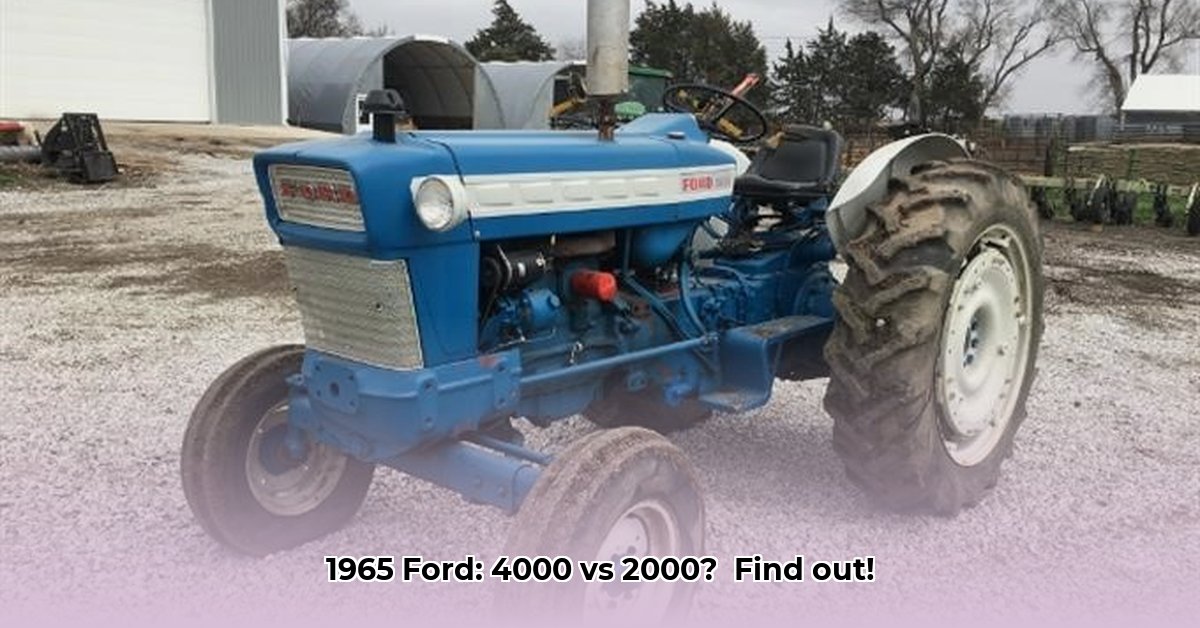
Under the Hood: Power and Performance Differences
The 1965 Ford 4000 and 2000, while both iconic, offer distinctly different powertrains. The Ford 4000 boasted a more robust 4-cylinder, 2.8-liter engine, delivering approximately 55 horsepower (gasoline models; diesel variants offered comparable increases). This contrasts sharply with the Ford 2000's 3-cylinder, 2.6-liter engine, producing around 36 horsepower. This horsepower disparity significantly impacts their capabilities. The 4000 readily tackled heavier tasks, while the 2000 proved better suited for lighter workloads. Is the extra power of the 4000 worth the increased fuel consumption? That's a question every potential owner must answer. For seat replacement options, check out this helpful guide: seat replacement guide.
Transmission: A Tale of Two Shifting Experiences
Transmission options also varied between the two models. The Ford 4000 offered the optional Select-O-Speed transmission, known for its smooth, effortless gear changes. This feature provided a significant advantage for operators facing long days in the field. The Ford 2000, conversely, featured more basic transmissions, demanding more physical effort from the operator during shifts. While seemingly minor, this difference greatly influences overall comfort and usability, particularly during extended periods of operation. Did this feature justify the higher purchase price of the 4000? Collectors today debate this point.
Fuel Efficiency: A Practical Consideration for Restoration
While precise fuel consumption figures for these vintage tractors are elusive, it's reasonable to expect the Ford 4000's larger engine to consume more fuel per hour. The Ford 2000, with its smaller engine, likely offered superior fuel economy. This becomes a critical factor when considering both operating costs and the overall expense of restoration. How can you improve fuel efficiency in a restored model? We'll address this in our restoration guide.
Beyond the Basics: Notable Differences in Design and Features
The differences between the Ford 4000 and 2000 extend beyond their engine and transmission systems. The Ford 4000 typically featured a greater lift capacity, making it more versatile for a wider range of implements. It also offered more fuel choices: gasoline, diesel, and even LP gas. In contrast, the Ford 2000 often lacked power steering, a significant consideration for operator comfort after extended use. These seemingly minor differences can significantly impact the overall user experience. How important is power steering to you; it's a key consideration during the restoration process.
Restoration: A Practical Guide for Ford 4000 and 2000 Enthusiasts
Restoring either a Ford 4000 or 2000 is a rewarding undertaking, but it demands careful planning and patience.
Step-by-Step Restoration Process:
Initial Assessment: Begin with a thorough examination of the tractor's condition, noting rust, missing parts, or damaged components. This assessment informs your restoration strategy. A detailed checklist is crucial.
Parts Sourcing: Locating parts for these vintage tractors can be challenging. Consult specialized suppliers, online forums, and classic tractor parts communities. Expect to invest time and effort.
Prioritize Basic Maintenance: Before major repairs, address essential maintenance tasks: change fluids, clean air filters, and lubricate moving components. Ensure the tractor runs smoothly before tackling more intricate issues.
Strategic Repair Approach: Tackle major repairs before minor ones. Work methodically, focusing on one system at a time to avoid overlooking details. Prioritize safety.
Finishing Touches: Once major repairs are completed, focus on cosmetic improvements like repainting and replacing decals.
Comparative Analysis: Ford 4000 vs. Ford 2000
| Feature | Ford 4000 | Ford 2000 |
|---|---|---|
| Engine Power | Higher horsepower (approx. 55 HP) | Lower horsepower (approx. 36 HP) |
| Transmission | Select-O-Speed (optional) – smoother shifting | Basic transmissions – more demanding shifting |
| Fuel Economy | Lower fuel efficiency | Higher fuel efficiency |
| Lift Capacity | Greater | Lower |
| Power Steering | Often standard | Usually optional or absent |
| Parts Availability | May be more challenging to find | Generally easier to source |
Making Your Choice: Ford 4000 or Ford 2000?
The ultimate decision hinges on individual needs and preferences. The Ford 4000 provides substantial power and heavy-duty performance, while the Ford 2000 offers a more compact machine with greater fuel efficiency. Both represent pieces of agricultural history, making the restoration of either a rewarding experience.